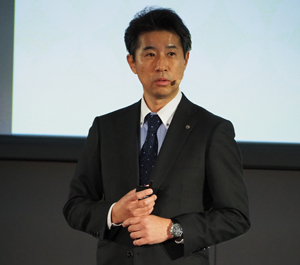Disaster Prevention Research Institute Launched NTT East


澁谷社長(President Shibutani)

笹倉担当部長(Sakura Department Head)
NTT East has launched a Disaster Prevention Research Institute to research new systems for regional disaster prevention, and will begin operations in April.
President Naoki Shibuya says, “Since I became president, one of the themes I wanted to tackle was disaster prevention. I will tackle disaster prevention as a mission to continue to protect the safety and security of the region. The reason we formed it into a research institute is to put our neutrality at the forefront. We have taken on a neutral tone because we believe that disaster prevention is not an area that should be approached lightly as a business.”
As is well known, disasters have become larger and more severe in recent years. In addition, the number of local government employees and corporate employees is decreasing due to the declining birthrate and aging population. At the same time, the number of people who are unable to evacuate independently is increasing.
President Shibuya said, “For example, NTT East’s Fukushima branch used to have 33 telephone managers alone. However, now there is only one branch manager. Previously, there were many bases in the region, and they supported the region together in times of emergency. How should we face disasters in the current situation where the size of local governments and companies is shrinking? From this perspective, a major theme is to strengthen disaster response capabilities by combining cutting-edge technologies such as ICT, digital, drones, and satellites.”
The Disaster Prevention Research Institute focuses on co-creating disaster-resistant towns. There are three specific pillars.
1. “Identifying disaster prevention risks according to the characteristics of each area and visualizing the disaster prevention capabilities of local governments”
2. “Working with the community to formulate a disaster prevention plan (BCP plan) that suits the area”
3. “Cultivating usable disaster prevention capabilities through disaster prevention drills and skill acquisition”
The aim is to actually go to the site and strengthen disaster prevention capabilities in a practical field-based manner.
“This will be a ‘field-style’ study in which we work closely with the national and local governments to thoroughly hone our skills in the field,” President Shibuya said.
The company has conducted disaster prevention assessments on 114 local governments and has begun to visualize where each local government has its disaster prevention weaknesses.
Satoshi Sasakura, manager of the Facilities Planning Department at the company’s Network Business Promotion Headquarters, explains, “We are examining around 100 interview items to visualize disaster prevention capabilities. Looking at it comprehensively, evacuation-related items are the biggest issue. For example, even if evacuation shelters are opened, residents do not evacuate, or the safety of people in need of special consideration in the event of a disaster is unknown. Important issues related to human life are an issue for many local governments.”
For this reason, for the time being, the Disaster Prevention Research Institute will focus on research that emphasizes protecting the lives of victims immediately after a disaster occurs.
Specifically, the themes to be considered include “how to disseminate evacuation information so that victims are not left behind in their escape,” “optimizing disaster response operations so that local government employees responding to disasters can focus on the task of protecting residents,” and “how to support people in need of special consideration, such as the elderly, who have difficulty evacuating independently.”
“We will provide recommendations based on the results of the Disaster Prevention Research Institute and accompany the research toward local implementation. We want to improve regional disaster prevention capabilities and create a local community where safety and security can be ensured even in the event of a disaster,” Sasakura stated.
※Translating Japanese articles into English with AI
